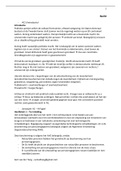College aantekeningen
B&C 3: Cognitieve Neuropsychologie - College aantekeningen
- Instelling
- Radboud Universiteit Nijmegen (RU)
Dit document bevat college aantekeningen van alle colleges van het vak Brain & Cognition 3: Cognitive Neuropsychology (SOW-PSB3BC15E).
[Meer zien]














